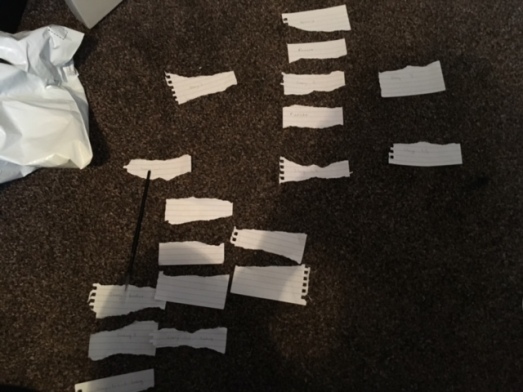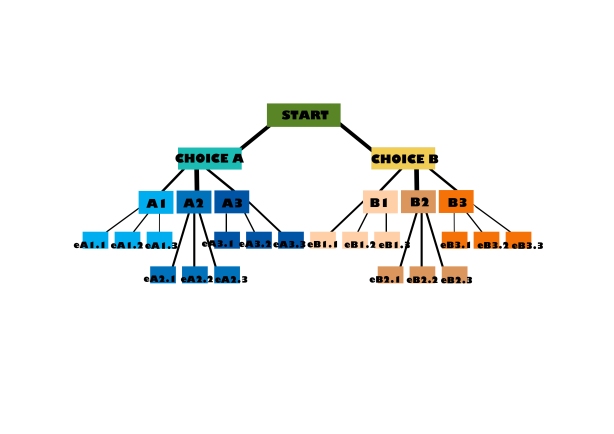*** Link to Google Drive Folder: Free resources for structure of your own IF – https://drive.google.com/open?id=0B5n4fpxFh7ENZ3RnTF9kQWpoaVE
Under CC license – use and modify for own purposes but credit ‘Samantha Clarke, Disruptive media Learning Lab, Coventry University’ for origins.***
Most people are familiar with the paradigm of ‘Choose Your Own Adventure’ books, but for those who are not familiar, wiki defines these books as:
“Choose Your Own Adventure is a series of children’s game books where each story is written from a second-person point of view, with the reader assuming the role of the protagonist and making choices that determine the main character’s actions and the plot’s outcome.
The player is asked to choose a path that they wish to take at key moments in the story or asked to roll a die/other random generator to select a path, allowing for the player to experience an individual route through a non-linear branching storyline. The player often feels more of an emotional connection to this process because they have had some influence on the outcome of narrative and therefore feel a sense of ownership over the choices they have made within the process. Tom Kuhlmann’s “3C model” to construct scenarios or interactive e-learning in his Rapid E-Learning Blog describes a 3C process in order to create digital-based, interactive choose your own adventures. The 3C’s are as follows:
Challenge: Pose the challenge to the player/reader. What are the problems they face and how is the emotion conveyed/fostered?
Choices: What are the choices available to the player/reader to deal with the challenge that has been posed?
Consequences: Your player/reader has selected a choice, what is the outcome from the choice they made? Are they better or worse off? Has it opened up the story further?
This is a great model in order to remember the basic principles of creating choose your own adventures and adequately describes the mechanics process at the fundamental level. Of course when you talk about interaction fiction and branched scenarios, inspiring connection and emotion from your players is a little more complex and requires a flair for creative writing.
There are some really great examples out there of digital choose your owns and interactive fictions for both entertainment (Trapped in Time (Simon Christiansen, PDF), Hadean Lands (Andrew Plotkin, Glulx), and education (look at work from Dr. Zorn who is based in York University). And whilst I am all for digital versions of choose your owns and IFs, I personally am more interested in developing physical books (such as the FF book series by Steve Jackson & Ian Livingstone) and props for this type of experience. Why? Well I believe allowing your players to play through a physical experience of something, allows for another level of emotional connection. Through the use of props, I believe you can create a really great haptic experience that stimulates the senses and enhances the storyline of the adventure. The element of mystery and intrigue can be embedded into these props to add puzzle-solving elements, and due to a physical space being adopted, these experiences could be made for multiplayer purposes, allowing for collaborative learning. In this area, I have recently been inspired by the work of Gisken Day and her experiences that use props to spur conversation and reflection. You can connect with her and her work here: Gisken Day.
So, in a bid to start experimenting in this area of using physical choose your owns for higher education/learning, I set about making a prototype in which we could plan a layout, structure and mechanics of a choose your own in which we could then adapt for various learning objectives at a later date.
I set about creating a story or fan fiction as it were, that was based loosely on a Stephen King novel. The story itself I felt was fairly easy to write, however it took me a long time (longer than anticipated) to figure out the structure.

As seen in the photo, it was very much trial and error to create the structure without any software (there are many out there such as Chatmapper), which to be honest would have helped if I had had the foresight to use (yes thats a paintbrush linking two paths!). But essentially the structure ended up becoming the following formula:

In this formula, players are presented with a starting piece of the story and given a challenge. They are offered a choice of either path A or B. Once they select a path of either A or B, they are presented with the consequences of their actions and another series of choices depending on the path taken, path A provides the choices A1, A2 or A3 and path B provides the choices B1, B2 or B3. Moving forward from here, the players, depending on the choice they pick, for an example lets say they chose to follow path A and then chose the path A1, are presented once again with the consequences of their actions and then a final ending choice of either eA1.1, eA1.2 or eA1.3. This was the basic structure that I settled on, as this could be expanded or condensed depending on the needs of the story/learning objectives. Within this structure each path way could contain a valuable learning objective for a player to explore or the whole experience could be used as part of a reflective exercise to show different outcomes of real-life scenarios (nursing/medicine/crisis management/business management etc.)
Once this structure was in place, I wanted to explore interesting ways in which players would be able to get from path to path. I settled on two options to play through the experience, offering the player/facilitator options to suit their needs.
The first option is the traditional, allow the player to choose which option they feel they would do in that situation. This allows for a fully player-led experience with the motivations and engagement properties that player choice and ownership offer.
The second option was to use Tangram geometric puzzles and a timing system to choose the paths for the player to follow. Based on the time it took for the player to complete the puzzle, this would lead to a designated path. This idea meant that time could be the factor that affected the outcomes, based on how quickly or slowly the player took equalled how long the player took in the game to respond to something that was happening. In this option, it was determined that different types of puzzles could be used in place of Tangrams depending on the depth of connection with the story and whether the puzzles themselves could be a deeper level of understanding for the story (uncovering extra materials).

Once this main structure was put together, I harnessed the power of help from my colleagues at the DMLL (Rebecca Morris and Olly Wood) to start constructing the real prototype that could be used to show how the experience worked.

Above shows Becky creating the system for the prototype and the layering of each of the paths for the physical experience, and below is the final experience compiled together into a folder.

As previously stated, I am really interested in how props and theatrics enhance the experience of the story and whether they foster a greater emotional engagement in the overall narrative. In each path that held the main branching storylines, physical props (made by Olly Wood) such as maps, shopping lists, photos etc were added with the exert of story. My plans are to include in a future evaluation of the experience whether or not props increase emotion/attachment to the narrative/experience to determine whether they have any meaningful affect on the players for future development.

Whats Next?
Now we have a fully completed prototype, our first exercise into adapting this for educational purposes, is to target the dry area of Research Methods. Currently we are assessing and developing learning objectives in which we can build into a structure that follows the prototype experience. Once this is completed, we hope to trial this with both undergrads and masters students within both Coventry and Salford Universities.
Further work to be considered that I would like to follow up on with this type of experience, is to develop a few different types of puzzles that could be integrated in place of the Tangrams which could have a deeper meaning/ uncovering of additional paths.
Would you like the format that we used to develop your own?
If you would like a template of the format that we used to construct the prototype then I am happy to provide you this for free, just send me a pm/email. All I ask is that you credit myself and the Disruptive Media Learning Lab, Coventry University, if you use the template in any experiences you create yourself.


Hi, may I have the template of the format that you used to construct the prototype? Yes I will yourself (Credit Continue?) and the Disruptive Media Learning Lab, Coventry University, if you use the template in any experiences you create yourself.
Thanks a million
LikeLike
Hi andy, sure no problem – I need to find the template out again and then can pass this along to you on Monday if that’s ok? Quite happy to send you the puzzles as well (these were very simple)
LikeLike
Much appreciated. Look forward to receiving them, thanks once again.
LikeLiked by 1 person
Hi Andy, if you want to send me an email to ab4588@coventry.ac.uk, I can share the google drive folder with you. It has all of the story bits, dividers and structure.
LikeLike
If you have share the kind of puzzles, that would be great!
LikeLike